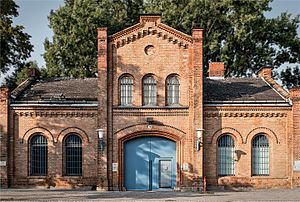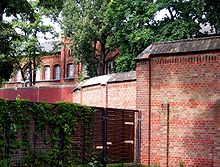Plötzensee correctional facility
 Gatehouse on Friedrich-Olbricht-Damm |
|
| Information about the institution | |
|---|---|
| Surname | Plötzensee correctional facility |
| Reference year | 1998 |
| Detention places | 345 |
The Plötzensee correctional facility ( ; popularly known as Plötze in Berlin ) is a correctional facility (JVA) on Friedrich-Olbricht-Damm in Berlin-Plötzensee . It is partially located on the premises of the Prussian Plötzensee prison . It serves the closed and open penal system for men. The institution goes back to the royal Plötzensee prison, the building stock of which is still in use today.
Partial institutions
- House 1 (A) is part of the old - in the meantime modernized - facility of the former Plötzensee prison, which served as the central execution site during the Nazi era .
- House 2 (with a new extension is the Berlin Prison Hospital - JVKB -) is a new building complex, which is also located on Friedrich-Olbricht-Damm.
- House 3 is located in the building of the former women's prison at Lehrter Strasse 60/61 in Moabit .
- House 4 is a new building built in October 1995 on Friedrich-Olbricht-Damm.
- House 5 was built at the end of 1974 from parts of the former press building for the Summer Olympics in Munich , has not been used since November 2010 and has since been demolished.
history
By decision of the Royal Ministry of Justice, the Plötzensee prison for around 1,400 prisoners was built between 1868 and 1879 on a 25.68- hectare site in the Tegel Forest, which was owned by the Royal Forestry Treasury. The designs were created jointly by Paul Spieker and Heinrich Hermann . Paul Spieker was also in charge of construction together with Otto Lorenz . The construction costs amounted to around 6.3 million marks (adjusted for purchasing power in today's currency: around 47 million euros). When Greater Berlin was formed in 1920, the area previously belonging to the Plötzensee estate in the Niederbarnim district was assigned to the then Charlottenburg district .
The entire complex with gatehouse, prison wings, civil servants' houses, kitchen buildings, boiler house and machine house is now a listed building . The institution church is located on the upper floor of the main building.
During the time of National Socialism , the Plötzensee prison was not only used for imprisonment, but also served (together with the Brandenburg-Görden prison ) as the “ central execution site for Execution District IV ”. Especially those sentenced to death by the Berlin Chamber Court and those sentenced to death by the People's Court established in 1934 were executed here; The executioner in charge was Wilhelm Röttger from 1942 to 1945 . The Plötzensee memorial on the Hüttigpfad commemorates the around 3,000 people who were victims of National Socialism here.
In 1939 the Jewish prayer room in what was then House 2 of the penal institution (today: House 8 of the juvenile prison) was closed and in 1943/1944 part of the building was destroyed by Allied air raids .
After the Second World War a juvenile detention center was located in the prison . In 1987 this moved to new buildings on the adjacent site to the north on Friedrich-Olbricht-Damm, but continues to use two houses of the historic institution. Also in the immediate vicinity (on the other side of the street from Friedrich-Olbricht-Damm) the JVA Charlottenburg was built in 1982 as a correctional facility for women, and since 1998 there have been 210 places for male prisoners in open prison.
In 2005, a central detention hospital (JVK Berlin) was built for all Berlin penal institutions on the site of the original prison. It replaces the Berlin prison hospital , which was previously located in the Moabit prison , with the branch in the Charlottenburg prison.
Since January 1, 2013, the Plötzensee JVA, the Charlottenburg JVA and the Berlin Prison Hospital have been part of a joint agency called the Plötzensee Prison.
At the beginning of 2018, the prison hit the headlines after a total of nine prisoners escaped there within five days.
Almost every third inmate in the Plötzensee prison is serving a substitute custodial sentence for repeated illegal driving at the Berlin transport company .
Others
- In the soap opera Good Times, Bad Times , the character “Lenny Cöster” (played by Alexander Becht ) had to serve a one-year prison sentence for bodily harm in the Plötzensee prison.
- The German rapper Marteria describes under his synonym Marsimoto in a song that he had to serve "a year in Plötzensee" because of stalking .
Web links
- Branch offices since 2013
- Plötzensee prison
- Juvenile detention center Berlin
- JVA Charlottenburg
- Prison Hospital Berlin
Individual evidence
- ↑ Berlin wants to sell women's prison. ( Memento from July 28, 2016 in the Internet Archive ) In: Berliner Morgenpost , July 22, 2008, accessed on July 28, 2016
- ↑ Entry in the Berlin State Monument List Plötzensee Prison (formerly) . Retrieved June 26, 2020
- ^ Plötzensee manor district . In: District lexicon of the Luisenstädtischer Bildungsverein
- ↑ Merger of authorities at the Plötzensee prison site. Berlin.de, December 28, 2012, accessed January 26, 2018 .
- ^ Jean-Pierre Ziegler: JVA Plötzensee in Berlin - open days. Spiegel Online , January 2, 2018.
- ↑ Sandra Dassler: Punishments: Every third person in Plötzensee is sitting because of dodging. In: Der Tagesspiegel . December 15, 2008, accessed October 19, 2010 .
- ^ Konrad Litschko: 135 dodgers behind bars: Free ride to jail. In: taz.de. October 14, 2010, accessed on October 19, 2010 : "High costs for small penalties: One third of those detained at the Berlin-Plötzensee prison are incarcerated for 'secret transport'."
Coordinates: 52 ° 32 '24.9 " N , 13 ° 19' 17.7" E


